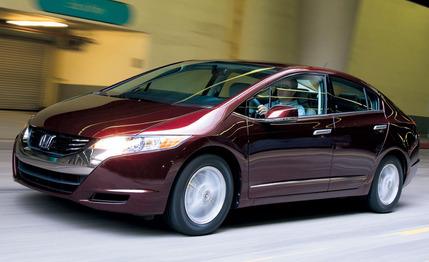 First Drive Review
First Drive Review
The Honda FCX Clarity is a technology of the future and may always be just that, but nonetheless, the Japanese automaker is cautiously bringing out its hydrogen fuel-cell car for a stroll. Starting this summer, Honda will lease the FCX for a fixed three-year contract at $600 per month without an option to buy. Production numbers are privately held, but Ferraris will be as common as paper clips by comparison. The lessees will be selected by a committee at American Honda Motor Company based largely on geographic location. If you don’t live in greater Los Angeles, where several of the nation’s few publicly accessible hydrogen stations currently pump the ethereal gas for about $5 per kilogram (the FCX holds 5.3 kilos, good for up to 270 miles of real-world driving, says Honda), forget about making the cut.
Hand built mostly from steel and some aluminum in Honda’s dream-car factory in Tochigi, Japan, the place that produced the Acura NSX and the Honda Insight hybrid, the Clarity’s eureka innovation is called the V Flow, or vertical flow stack.
Fuel cells make electricity by inducing hydrogen atoms through a membrane that strips away their electrons. Honda’s design uses stamped stainless-steel generating plates that are grooved with vertical gas channels shaped in a wave pattern that increases surface area and leverages gravity to drain out waste water, an important factor in power production and cold-temperature startup.
Meanwhile, the plates are cross-cut with horizontal coolant channels that more efficiently control internal temperatures—all of which allows Honda to increase electrical output from its previous stack by 16 percent to 100 kilowatts while shrinking the volume by 21 percent and the weight by 30 percent to 148 pounds.
In the Clarity, the stack is not much larger than two desktop-computer towers and fits neatly into a tunnel between the front seats. A single 45-gallon tank behind the rear seats stores gaseous hydrogen at up to 5000 psi, and a small lithium-ion battery pack buffers the stack’s power delivery and stores energy from the regenerative brakes.
Sized between the Civic and Accord, the 3600-pound Clarity disappears in traffic and drives like the Accord with which it shares its control-arm front suspension. Instead of engine growl, a distant motor hums and a slightly disturbing, stepping-on-a-cat scream emanates from the Roots-type compressor feeding outside air to the stack. A split-level, Syd Mead–inspired dash features a blue hydrogen “consumption ball” that grows larger and turns amber the more you press the gas pedal.
After shelling out $21,600 over three years, you’d be forgiven for expecting to own at least part of this smallish sedan rather than a wad of canceled checks. Honda doesn’t agree. Plated with platinum catalysts and lined with exotic membranes, fuel cells are still NASA-priced. The Clarity is a money-losing experiment at encouraging hydrogen infrastructure development, the company says. Be part of it or don’t. Chances are, you’ll never get the choice.